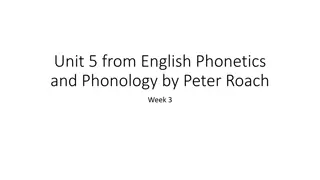Introduction to Theoretical Phonology: Understanding Phonemes and Speech Sounds
The lecture explores the fundamental concepts of phonology, focusing on phonemes, speech sounds, phonological theories, and their historical background. It delves into the functions of phonemes in forming language units, distinguishing words, and their connection to meaning. Various theories and functions within phonology are discussed, emphasizing the intricate relationship between phonology, linguistics, and prosodic features.
Download Presentation

Please find below an Image/Link to download the presentation.
The content on the website is provided AS IS for your information and personal use only. It may not be sold, licensed, or shared on other websites without obtaining consent from the author.If you encounter any issues during the download, it is possible that the publisher has removed the file from their server.
You are allowed to download the files provided on this website for personal or commercial use, subject to the condition that they are used lawfully. All files are the property of their respective owners.
The content on the website is provided AS IS for your information and personal use only. It may not be sold, licensed, or shared on other websites without obtaining consent from the author.
E N D
Presentation Transcript
1 THEORETICAL PHONOLOGY Phonetics Lecturer: Irina K. Voytovich The Phoneme
In this lecture: What is phonology The phoneme: its features and functions The flow of speech Phonemes, allophones and other variations of speech sounds The phonological oppositions theory Phonemic inventory and system
To sum it up: Which comes first the dilemma is still there Phonology is strongly connected to the linguistics, relationship to meaning and the function of consonant and vowel sounds, syllabic structure, word accent and prosodic features, such as pitch, stress and tempo
Phonology studies 4 basic theories 3 basic functions The phoneme theory Constitutional The syllable theory Distinctive The stress theory Recognitive The intonation theory
Background The 6thcentury BC Ancient Greek Philosophy 1875 Louis Havet a French Latinist 1878 Memoir Ferdinand de Saussure a Swiss linguist aged 21 1887 Jan Baudouin de Courtenay a Polish linguist 1912 Lev V. Shcherba a Russian linguist 1929-1939 Principles of Phonology Nikolai S. Trubetzkoy a Russian linguist
Phoneme: definition The phoneme is unit of the sound system of the language. the smallest, linear / segmental indistinguishable, independent
Most important functions of a phoneme Constitutive - phonemes form the sound shells of significant language units, such as morphemes, words, sentences, paragraphs, texts [e] [ai] [h] [p] [t] [u] [k] [l] [hait] [tuk] [luk] [put] [tel] [hel] [lait] [tail] [let]
Distinctive function Words are distinguished by means of phonemes [tip] [top] [teip] [taip] [tail] [mail] [lip] [lit] [a:] [ou] Phonemes have no meaning but they are potentially connected with it.
Recognitive function To recognize and understand words, we must use the allophones of the phonemes correctly Pride Bride Pie Buy
The flow of speech Written speech Oral speech Neither articulatory nor acoustically is it divided into sounds This is a purely linguistic phenomenon
Black clouds covered the sun Words Syntactic function Morphological structure Lexical meaning Morphemes Lexical meaning Grammar meaning Sounds Associative analysis Minimal pairs Morphemic juncture
Associative analysis N. Trubetzkoy Principles of Phonology Comes from aristocratic family His father was the rector of Moscow University His uncle was a well-known philosofer His brother was a writer Born 4 (16). 04. 1890 in Moscow Died on 25.06. 1938 (aged 48 ) in Viena Linguistic imput: the phoneme theory structural method
There are five phonemes in the word DUTY because we meet them in many other words This method is based on psychological associations and is very subjective [d] [j] [u ] [t] [ ] day dog union few Tuesday fool cool thirty fortress pity dusty
Associative analysis week points Subjective methods are not reliable Different phonemes may be viewed upon as one and the same by nonnative speakers tin ten tan ten thirty Compound phonemes like diphthongs can get split and give an effect of two different phonemes there they now know
Minimal pairs Introduced by N. Trubetzkoy in his Principals of Phonology , this method of speech flow segmentation became popular the world over. It is based on the opposition of phonemes and their ability to distinguish pairs of words in meaning.
Minimal pairs are pairs of words that differ in one sound and have different meaning tip tap - top - pin pen pan - fan - man tan pan The weak points The number of minimal pairs in the language is limited You can also get a wrong impression that phonemes are meaningful units of the language
Morphemic juncture Lev Shcherba, Mauroce Grammont
St.Petersburg State University, dpt for phonetics Pitchforks
Morphemic juncture Lev Shcherba, Mauroce Grammont The method states that: The flow of speech segmentation is possible only phonologically but not phonetically. Being a non-meaningful unit of the language, the phoneme, nevertheless, is potentially connected with the lexical or grammatical meaning within the morpheme. The systematic approach to the language is very important
Morphemic juncture: actor If two sounds find themselves on the morphemic juncture, they are divisible: act -or The morphemic junctures must exist in the system of the language, not at all in one word: ac-t because of pick-ed We will find it difficult to divide ac, so we ll have to look for another method: act-ant.
Morphemic juncture: weak points too complicated; the number of morphemic junctures is limited even in the language system; requires the application of the method of minimal pairs.
The result of the flow of speech segmentation: what is next? Which sounds belong to one and the same phoneme? Which sounds belong to different phonemes? The idea of a Distribution - this is what can help
Phonemes, allophones and optional variants Types of units Types of distribution Phonemes Contrast Allophones Complementary Optional variants Free variation
The rules: If two sounds can meet in one and the same position and the meaning of the word changes these sound belong to two different phonemes because they are found in the distribution of contrast. [pin] [pen] If two sounds with more or less similar features never meet in one and the same position but compliment each other - they are allophones of one phoneme, because they are found in a complementary distribution. [til] [to:l] If two sounds do meet in one and the same position but the meaning of the is not changed they are optional variants of the phoneme and they find themselves in the distribution of free variation. When
Phonemic inventory and system The system of phonemes is the relationship of phonemes between each other
System features The relations between phonemes in the system are permanent. Single phonemes are in certain relations among themselves. Not only individual phonemes, but also groups of phonemes are in certain relations among themselves.
What makes it possible? Each phoneme is a combination of phonologically relevant and irrelevant features. Phonologically relevant features are constant distinctive features. Irrelevant features unite phonemes.
The theory of phonological oppositions To study the system of phonemes is to study the oppositions they form in the language. Opposition is a unit in which a sound can differentiate the meanings of two words. N. Trubetzkoy developed the classification of phonological oppositions
To study the system of phonemes is to study the oppositions they form in the language.
Types of phonological oppositions The oppositions are classified on the basis on: relation to members of the opposition: private [p]-[b] gradual [i]- [e ]- [ ] equipollent oppositions [f]-[k]
Types of phonological oppositions Classification of oppositions in their relation to the system of oppositions as a whole: multidimensional and one-dimensional w-h p-b isolated and proportional oppositions. w-h p-b t-d k-g
Classification of oppositions by the degree of their sense-distinguishing force or effectiveness in various positions: permanent and neutralized opposition Only one-dimensional oppositions can be neutralized
Neutralized opposition Russian voiced consonants English unstressed vowels shwa Subject object Subject object
The result of neutralization School Unit Result Prague school Archiphoneme Only irrelevant features Moscow school Hyper phoneme [t / d] Both relevant and irrelevant features St.Peterburg school Phoneme The phoneme we hear
Practical application Classifications
Phonemic inventory Phonemic inventory is the total number of phonemes functioning in the language English: 44 = 20 + 24 There are difficult cases
Difficult cases Vowels: schwa, diphthongs triphthongs Consonants: sonants, affricates, w-wh, h- [ ]
Attendance check-up Now you are welcome to give examples illustrating the basic functions of the phoneme
Thank you for attention! ivoytovich@yandex.ru ivoytovich@yandex.ru























